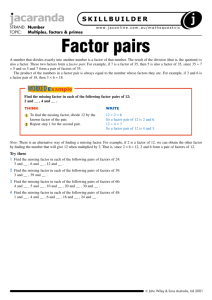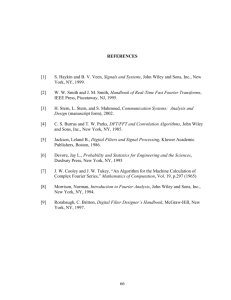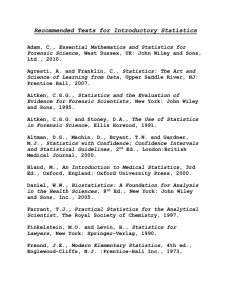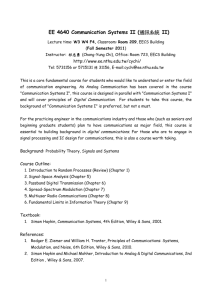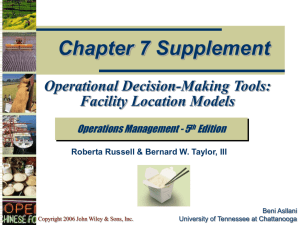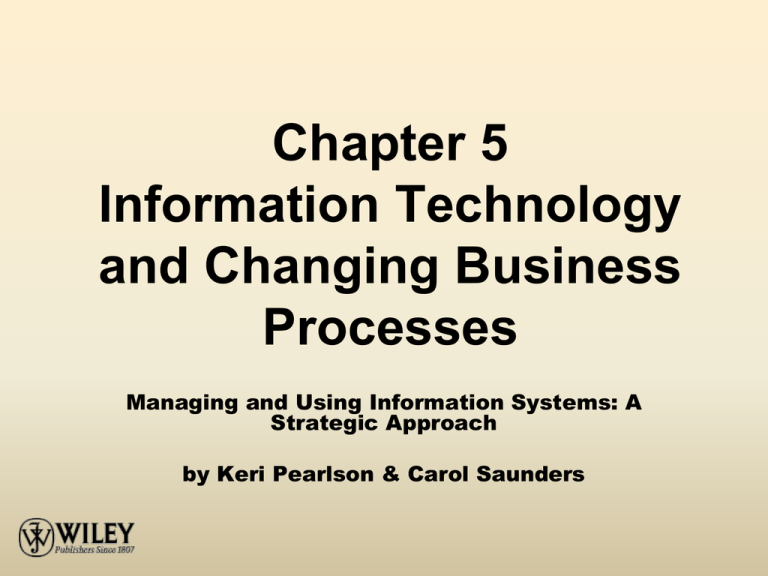
Chapter 5
Information Technology
and Changing Business
Processes
Managing and Using Information Systems: A
Strategic Approach
by Keri Pearlson & Carol Saunders
Learning Objectives
• List how IT enables business change
• Identify ways in which IT can impede business
change
• Understand the problems that are caused by the
functional (silo) perspective of a business
• Identify how the process perspective keeps the
big picture in view and how IT can be used to
facilitate this perspective
• Define TQM and BPR and explain how they are
used to transform a business
• Explain an enterprise system and how they are
used to implement organizational change
Copyright 2010 John Wiley & Sons, Inc.
Real World Examples
• Cemex, a concrete company located in Mexico, needed to
“transform” the way they did business.
– After 16 years they changed their customer key processes.
– The CEO did this by challenging management to address the processes
that caused late shipments and unforseable demand.
– Cemexnet was built to link all of the plants together and to keep them up to
date on supply and demand issues.
– GPS system was implemented to help manage their fleet of trucks.
– They also created a set of global processes that enabled customers,
suppliers, and distributors to manage their orders.
• Dramatic results occurred due to this transformation.
– Delivery windows went from 3 hours to 20 minutes with a 98% rate.
– Sales increased 19% in the first quarter.
– Their reputation was greatly enhanced.
• Cemex reset the bar for all others in the industry with their
customer-orientation, use of technology and process
redesign
Copyright 2010 John Wiley & Sons, Inc.
SILO PERSPECTIVE
VERSES
BUSINESS PROCESS
PERSPECTIVE
Copyright 2010 John Wiley & Sons, Inc.
Silo (Functional) Perspective
• The silo perspective views the business as
discrete functions (accounting, sales, production,
etc.).
– Figure 5.1 shows a traditional organizational chart
which is how a functional business is organized.
• Each functional area determines its core
competencies and focuses on what it does best.
• Advantages:
– Allows optimization of expertise.
– Group like functions together for learning.
• Disadvantages:
– Significant sub-optimization.
– Tend to lose sight of overall organizational objectives.
Copyright 2010 John Wiley & Sons, Inc.
Figure 5.1 Hierarchical Structure
Copyright 2010 John Wiley & Sons, Inc.
Process Perspective
• Keeps the big picture in view.
• Focuses on work being done to create optimal
value for the business.
• Process is defined as an interrelated, sequential
set of activities and tasks that turns inputs into
outputs, and includes the following:
– A beginning and an end
– Inputs and outputs
– A set of tasks (subprocesses) that transform
the inputs into outputs
– A set of metrics for measuring effectiveness
Copyright 2010 John Wiley & Sons, Inc.
Process Perspective
• Examples of business processes include:
–
–
–
–
–
customer order fulfillment
manufacturing, planning and execution
payroll
financial reporting
procurement (see figure 5.2)
Copyright 2010 John Wiley & Sons, Inc.
Figure 5.2 – Sample business process
Copyright 2010 John Wiley & Sons, Inc.
Process Perspective
• Advantages:
– Helps avoid or reduce duplicate work.
– Facilitate cross-functional communication.
– Optimize business processes.
• Figure 5.3 shows the cross-functional view of
processes as they cross departments
(functions).
Copyright 2010 John Wiley & Sons, Inc.
Figure 5.3 Cross-functional nature of business processes
Copyright 2010 John Wiley & Sons, Inc.
Process Perspective
• When managers gain the process perspective
they begin to lead their organizations to change.
– Question status quo.
– Don’t accept “because we have always done it that
way” as an answer to why business is done in a
particular way.
– Allows managers to analyze business’s processes in
light of larger goals.
• Zara is a good example of a process perspective
business (see chapter 2).
Copyright 2010 John Wiley & Sons, Inc.
Silo Perspective
Business Process
Perspective
Definition
Self-contained functional units
such as marketing, operations,
finance, and so on
Interrelated, sequential set
of activities and tasks that
turns inputs into outputs
Focus
Functional
Cross-functional
Goal
Accomplishment
Optimizes on functional goals,
which might be a suboptimal
organizational goal.
Optimizes on organizational
goals, or “big picture”
Benefits
Highlighting and developing core
competencies; Functional
efficiencies
Avoiding work duplication
and cross-functional
communication gaps;
organizational effectiveness
Figure 5.4 Comparison of Silo Perspective and
Business Process Perspective
Copyright 2010 John Wiley & Sons, Inc.
THE TOOLS FOR CHANGE
Copyright 2010 John Wiley & Sons, Inc.
Incremental Change
• Total Quality Management (TQM) is a tool
for change that uses small incremental
changes.
• Personnel often react favorably to TQM.
• Greater personnel control and ownership.
• Change is viewed as less of a threat.
• Six-Sigma is one popular approach to
TQM
Copyright 2010 John Wiley & Sons, Inc.
Six Sigma
• Six Sigma asserts that –
– Continuous efforts to achieve stable and predictable
process results are of vital importance to business
success.
– Manufacturing and business processes have
characteristics that can be measured, analyzed,
improved and controlled.
– Achieving sustained quality improvement requires
commitment from the entire organization, particularly
from top-level management.
• It seeks to eliminate defects from any process.
Copyright 2010 John Wiley & Sons, Inc.
Radical Change
• Business Process Reengineering (BPR) is a
more “radical” change management tool.
• Attain aggressive improvement goals.
• Goal is to make a rapid, breakthrough impact on
key metrics.
• Figure 5.6 shows the difference over time of the
radical (BPR) and incremental (TQM)
approaches to change.
• Greater resistance by personnel.
• Use only when major change is needed.
Copyright 2010 John Wiley & Sons, Inc.
Figure 5.5 Comparison of radical and incremental improvement
Copyright 2010 John Wiley & Sons, Inc.
The Process for Radical Redesign
• The different approaches for radical redesign all
include:
– Begin with a vision of which performance metrics best
reflect the success of overall business strategy.
– Make changes to the existing process.
– Measure the results using the predetermined metrics.
• Figure 5.6 illustrates a general view of radical
design.
• Figure 5.7 illustrates a method for redesigning a
business process.
• Tool used to understand a business process is a
workflow diagram.
Copyright 2010 John Wiley & Sons, Inc.
Figure 5.6 – Conceptual flow of process design
Copyright 2010 John Wiley & Sons, Inc.
Figure 5.7 – Method for redesigning a business process
Copyright 2010 John Wiley & Sons, Inc.
Risks of Radical Redesign
• Lack of senior management support.
• Lack of a coherent communications
program.
• Introducing unnecessary complexity into
the new process design.
• Introducing unnecessary complexity into
the new process design.
• Combining reengineering with downsizing
Copyright 2010 John Wiley & Sons, Inc.
AGILITY AND CONSTANTLY
REDISGNING PROCESSES
Agile Processes
• Agile processes are processes that iterate
through a constant renewal cycle of design,
deliver, evaluate, redesign, and so on.
• Ultimate goal for some are agile processes that
reconfigure themselves as they ‘learn.
• For a process to be agile necessitates a high
degree of use of IT.
• Processes that run entirely on the Internet are
candidates for becoming agile processes.
Copyright 2010 John Wiley & Sons, Inc.
Shared Services
• Horizontal integration - term for looking
beyond individual business processes and
considering the bigger, cross functional picture
of the corporation.
– Integrated databases, web 2.0 technologies and
services, and common infrastructure are the tools IT
brings to the implementation of horizontal integration.
• Many organizations have restructured their
common business processes into a shared
services model.
– This model consolidates all individuals from all
business units into a single organization, run
centrally, and utilized by each business unit.
Copyright 2010 John Wiley & Sons, Inc.
Business Process Management
(BPM) Systems
Copyright 2010 John Wiley & Sons, Inc.
BPM
• In the 1990s, a class of systems emerged to
help manage workflows in the business.
• They primarily helped track document-based
processes where people executed the steps of
the workflow.
• They go way beyond the documentmanagement capabilities, including features that
manage person-to-person process steps,
system-to-system steps, and those processes
that include a combination.
– Systems include process modeling, simulation, code
generation, process
execution, monitoring, and
Copyright 2010 John Wiley & Sons, Inc.
integration capabilities for both company-based and
FIGURE 5.8 Sample BPM Architecture: Appian Enterprise
Copyright 2010 John Wiley & Sons, Inc.
ENTERPRISE SYSTEMS
Copyright 2010 John Wiley & Sons, Inc.
Enterprise Systems
• A set of information systems tools used to
enable information flow within and between
processes.
• Enterprise systems are comprehensive software
packages.
• ERP (Enterprise Resource Planning) software
packages are the most frequently discussed
type of enterprise system.
• Designed to manage the potentially hundreds of
systems throughout a large organization.
• SAP is the most widely used ERP software
package.
Copyright 2010 John Wiley & Sons, Inc.
Characteristics of Enterprise
Systems
• Integration – seamlessly integrate information
flows throughout the company.
• Packages – they are commercial packages
purchased from software vendors (like SAP,
Oracle, Peoplesoft, etc.).
• Best practices – reflect industry best practices.
• Some assembly required – the systems need to
be integrated with the existing hardware, OS’s,
databases, and telecommunications.
• Evolving – the systems continue to change to fit
the needs of the diverse marketplace.
Copyright 2010 John Wiley & Sons, Inc.
Benefits and Disadvantages of
Enterprise Systems
• Benefits:
– All modules easily communicate together.
– Useful tools for centralizing operations and decision
making.
– Can reinforce the use of standard procedures.
• Disadvantages:
– Implementation is an enormous amount of work.
– Most require some level of redesigning business
processes.
– Hefty price tag (sold as a suite).
– They are risky.
Copyright 2010 John Wiley & Sons, Inc.
The Adoption Decision
• Sometimes it is appropriate to let the enterprise
system drive business process redesign.
– When just starting out.
– When organizational processes not relied upon for
strategic advantage.
– When current systems are in crisis.
• Sometimes it is inappropriate to let the
enterprise system drive business process
redesign.
– When changing an organizations processes that are
relied upon for strategic advantage.
– When the package does not fit the organization.
– When there is a lack of top management support.
Copyright 2010 John Wiley & Sons, Inc.
Integrated Supply Chains
• Processes linked across companies.
• Supply chain begins with raw materials
and ends with a product/service.
• Globalization of business and ubiquity of
communication networks permits use of
suppliers from anywhere.
• Requires coordination among partners of
the integrated supply chain.
Copyright 2010 John Wiley & Sons, Inc.
Integrated Supply Chain
• Challenges include:
– Information integration.
– Synchronized planning.
– Workflow coordination.
• Leads to new business models.
– For example when banks link up to
businesses new financial services are offered
such as on-line payments.
– Companies list needs and vendors
electronically bid to be the supplier.
Copyright 2010 John Wiley & Sons, Inc.
FOOD FOR THOUGHT:
IS ERP A UNIVERSAL
SOLUTION?:
CROSS-CULTURAL
BUSINESS PROCESSES
Cross-Cultural Business
Processes
• Major vendors, SAP and Oracle, show a western
bias in reporting best practices.
• Due to problems encountered, businesses in
non-western companies/locations are turning to
local vendors.
• If the system is based on a cultural model that
conflicts with the local customs and which can
not easily be accommodated by the ERP it
should NOT be implemented.
Copyright 2010 John Wiley & Sons, Inc.
SUMMARY
Summary
• IS can enable or impede business change.
• You must look at business process to
understand the rule IS plays in business
transformation.
• TQM or BRP are normally used to make
changes to business processes.
• ERP systems can be used to affect
organizational transformation.
• Information systems are useful tools to both
enable and manage business transformation.
Copyright 2010 John Wiley & Sons, Inc.
• Copyright 2010 John Wiley & Sons, Inc.
•
All rights reserved. Reproduction or translation of this work beyond that
named in Section 117 of the 1976 United States Copyright Act without the
express written consent of the copyright owner is unlawful. Request for
further information should be addressed to the Permissions Department,
John Wiley & Sons, Inc. The purchaser may make back-up copies for
his/her own use only and not for distribution or resale. The Publisher
assumes no responsibility for errors, omissions, or damages, caused by the
use of these programs or from the use of the information contained herein
Copyright 2010 John Wiley & Sons, Inc.

